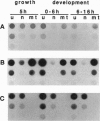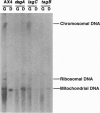Abstract
Dictyostelium discoideum cells initiate development when nutrients are depleted. DNA synthesis decreases rapidly thereafter but resumes during late aggregation, only in prespore cells. This observation has been previously interpreted as indicating progression of prespore cells through the cell cycle during development. We show that developmental DNA replication occurs only in mitochondria and not in nuclei. We also show that the prestalk morphogen known as differentiation-inducing factor 1 can inhibit mitochondrial respiration. A model is proposed for cell type divergence, based on competition to become prespores, that involves mitochondrial replication in prespore cells and reduction of mitochondrial activity in prestalk cells.
Full text
PDF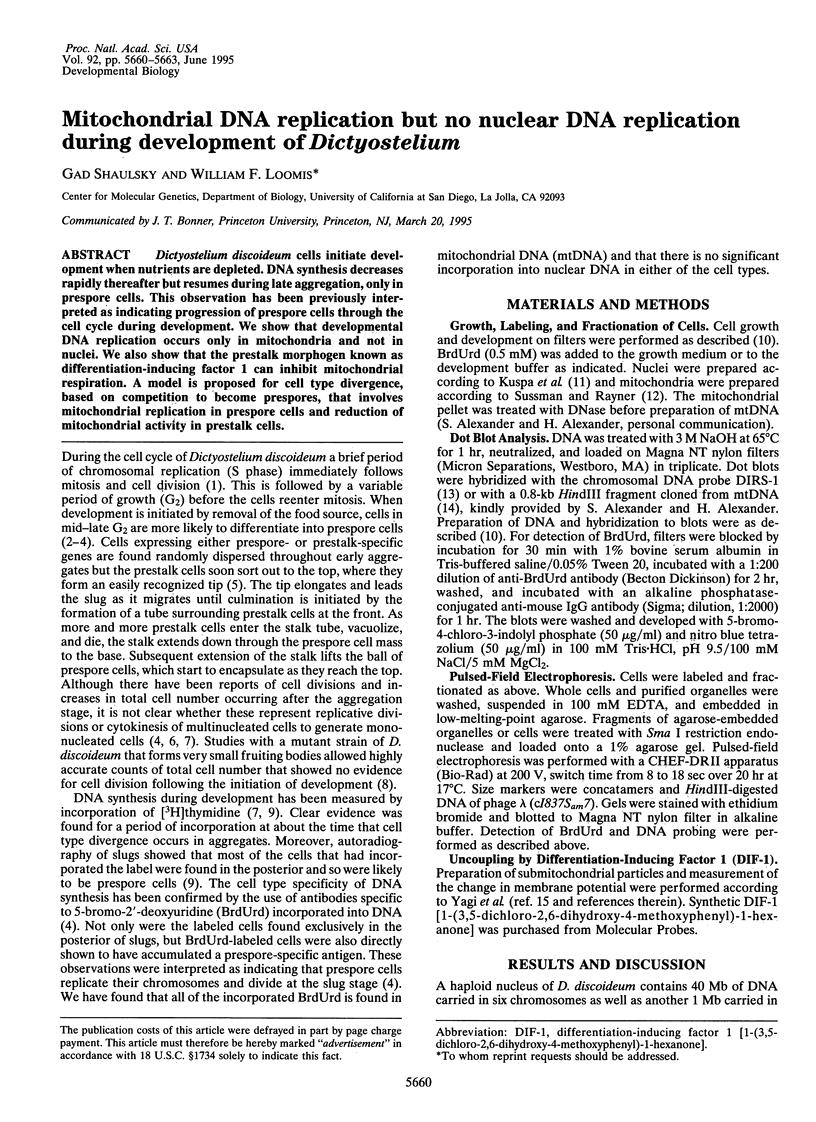
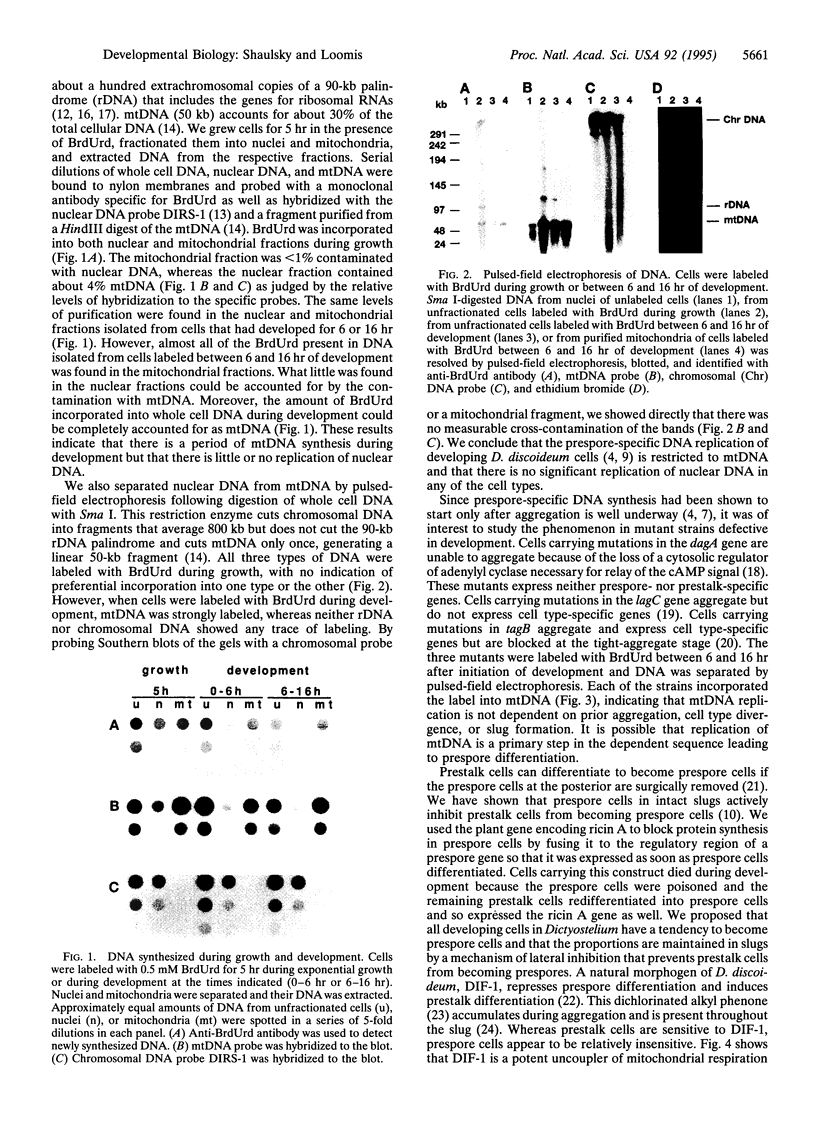

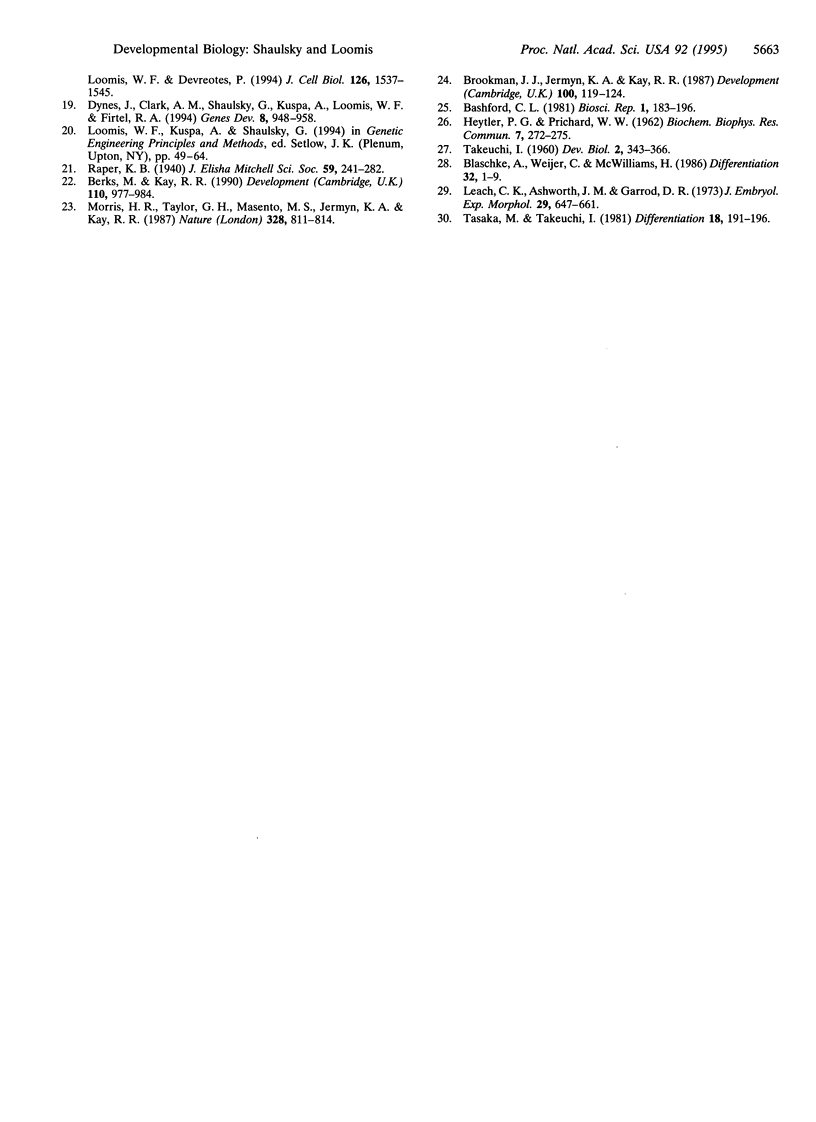
Images in this article
Selected References
These references are in PubMed. This may not be the complete list of references from this article.
- Bashford C. L. The measurement of membrane potential using optical indicators. Biosci Rep. 1981 Mar;1(3):183–196. doi: 10.1007/BF01114904. [DOI] [PubMed] [Google Scholar]
- Berks M., Kay R. R. Combinatorial control of cell differentiation by cAMP and DIF-1 during development of Dictyostelium discoideum. Development. 1990 Nov;110(3):977–984. doi: 10.1242/dev.110.3.977. [DOI] [PubMed] [Google Scholar]
- Brookman J. J., Jermyn K. A., Kay R. R. Nature and distribution of the morphogen DIF in the Dictyostelium slug. Development. 1987 May;100(1):119–124. doi: 10.1242/dev.100.1.119. [DOI] [PubMed] [Google Scholar]
- Cockburn A. F., Taylor W. C., Firtel R. A. Dictyostelium rDNA consists of non-chromosomal palindromic dimers containing 5S and 36S coding regions. Chromosoma. 1978 Dec 21;70(1):19–29. doi: 10.1007/BF00292212. [DOI] [PubMed] [Google Scholar]
- Durston A. J., Vork F. The spatial pattern of DNA synthesis in Dictyostelium discoideum slugs. Exp Cell Res. 1978 Sep;115(2):454–457. doi: 10.1016/0014-4827(78)90308-7. [DOI] [PubMed] [Google Scholar]
- Dynes J. L., Clark A. M., Shaulsky G., Kuspa A., Loomis W. F., Firtel R. A. LagC is required for cell-cell interactions that are essential for cell-type differentiation in Dictyostelium. Genes Dev. 1994 Apr 15;8(8):948–958. doi: 10.1101/gad.8.8.948. [DOI] [PubMed] [Google Scholar]
- Firtel R. A., Bonner J. Characterization of the genome of the cellular slime mold Dictyostelium discoideum. J Mol Biol. 1972 May 28;66(3):339–361. doi: 10.1016/0022-2836(72)90419-6. [DOI] [PubMed] [Google Scholar]
- Gomer R. H., Firtel R. A. Cell-autonomous determination of cell-type choice in Dictyostelium development by cell-cycle phase. Science. 1987 Aug 14;237(4816):758–762. doi: 10.1126/science.3039657. [DOI] [PubMed] [Google Scholar]
- HEYTLER P. G., PRICHARD W. W. A new class of uncoupling agents--carbonyl cyanide phenylhydrazones. Biochem Biophys Res Commun. 1962 May 4;7:272–275. doi: 10.1016/0006-291x(62)90189-4. [DOI] [PubMed] [Google Scholar]
- Insall R., Kuspa A., Lilly P. J., Shaulsky G., Levin L. R., Loomis W. F., Devreotes P. CRAC, a cytosolic protein containing a pleckstrin homology domain, is required for receptor and G protein-mediated activation of adenylyl cyclase in Dictyostelium. J Cell Biol. 1994 Sep;126(6):1537–1545. doi: 10.1083/jcb.126.6.1537. [DOI] [PMC free article] [PubMed] [Google Scholar]
- Kuspa A., Maghakian D., Bergesch P., Loomis W. F. Physical mapping of genes to specific chromosomes in Dictyostelium discoideum. Genomics. 1992 May;13(1):49–61. doi: 10.1016/0888-7543(92)90201-3. [DOI] [PubMed] [Google Scholar]
- Leach C. K., Ashworth J. M., Garrod D. R. Cell sorting out during the differentiation of mixtures of metabolically distinct populations of Dictyostelium discoideum. J Embryol Exp Morphol. 1973 Jun;29(3):647–661. [PubMed] [Google Scholar]
- McDonald S. A., Durston A. J. The cell cycle and sorting behaviour in Dictyostelium discoideum. J Cell Sci. 1984 Mar;66:195–204. doi: 10.1242/jcs.66.1.195. [DOI] [PubMed] [Google Scholar]
- Morris H. R., Taylor G. W., Masento M. S., Jermyn K. A., Kay R. R. Chemical structure of the morphogen differentiation inducing factor from Dictyostelium discoideum. 1987 Aug 27-Sep 2Nature. 328(6133):811–814. doi: 10.1038/328811a0. [DOI] [PubMed] [Google Scholar]
- Shaulsky G., Loomis W. F. Cell type regulation in response to expression of ricin A in Dictyostelium. Dev Biol. 1993 Nov;160(1):85–98. doi: 10.1006/dbio.1993.1288. [DOI] [PubMed] [Google Scholar]
- Sussman R., Rayner E. P. Physical characterization of deoxyribonucleic acids in Dictyostelium discoideum. Arch Biochem Biophys. 1971 May;144(1):127–137. doi: 10.1016/0003-9861(71)90462-0. [DOI] [PubMed] [Google Scholar]
- TAKEUCHI I. The correlation of cellular changes with succinic dehydrogenase and cytochrome oxidase activities in the development of the cellular slime molds. Dev Biol. 1960 Aug;2:343–366. doi: 10.1016/0012-1606(60)90021-x. [DOI] [PubMed] [Google Scholar]
- Tasaka M., Takeuchi I. Role of cell sorting in pattern formation in Dictyostelium discoideum. Differentiation. 1981;18(3):191–196. doi: 10.1111/j.1432-0436.1981.tb01122.x. [DOI] [PubMed] [Google Scholar]
- Weijer C. J., Duschl G., David C. N. A revision of the Dictyostelium discoideum cell cycle. J Cell Sci. 1984 Aug;70:111–131. doi: 10.1242/jcs.70.1.111. [DOI] [PubMed] [Google Scholar]
- Williams J. G., Duffy K. T., Lane D. P., McRobbie S. J., Harwood A. J., Traynor D., Kay R. R., Jermyn K. A. Origins of the prestalk-prespore pattern in Dictyostelium development. Cell. 1989 Dec 22;59(6):1157–1163. doi: 10.1016/0092-8674(89)90771-x. [DOI] [PubMed] [Google Scholar]
- Yagi T., Matsuno-Yagi A., Vik S. B., Hatefi Y. Modulation of the kinetics and the steady-state level of intermediates of mitochondrial coupled reactions by inhibitors and uncouplers. Biochemistry. 1984 Feb 28;23(5):1029–1036. doi: 10.1021/bi00300a035. [DOI] [PubMed] [Google Scholar]
- Zada-Hames I. M., Ashworth J. M. The cell cycle and its relationship to development in Dictyostelium discoideum. Dev Biol. 1978 Apr;63(2):307–320. doi: 10.1016/0012-1606(78)90136-7. [DOI] [PubMed] [Google Scholar]
- Zimmerman W., Weijer C. J. Analysis of cell cycle progression during the development of Dictyostelium and its relationship to differentiation. Dev Biol. 1993 Nov;160(1):178–185. doi: 10.1006/dbio.1993.1296. [DOI] [PubMed] [Google Scholar]
- Zuker C., Cappello J., Lodish H. F., George P., Chung S. Dictyostelium transposable element DIRS-1 has 350-base-pair inverted terminal repeats that contain a heat shock promoter. Proc Natl Acad Sci U S A. 1984 May;81(9):2660–2664. doi: 10.1073/pnas.81.9.2660. [DOI] [PMC free article] [PubMed] [Google Scholar]



